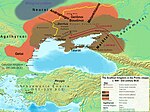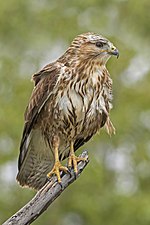The Eurasian Steppe, also called the Great Steppe or The Steppes, is the vast steppe ecoregion of Eurasia in the temperate grasslands, savannas and shrublands...
36 KB (4,025 words) - 18:57, 24 September 2024
it with the Kazakh Steppe in Central Asia, making it a part of the larger Eurasian Steppe. Geopolitically, the Pontic-Caspian Steppe extends from northeastern...
15 KB (1,214 words) - 21:59, 24 July 2024
Uzbekistan to the Altai, Koppet Dag and Tian Shan ranges in China. The Eurasian Steppe is speculated by David W. Anthony to have had a role in the spread...
10 KB (1,042 words) - 17:22, 18 September 2024
Eurasian nomads form groups of nomadic peoples who have lived in various areas of the Eurasian Steppe. History largely knows them via frontier historical...
25 KB (2,851 words) - 18:56, 6 November 2024
Scythians (redirect from Scythian kingdom in the Pontic steppe)
Agathyrsi and the Cimmerians as the dominant power on the western Eurasian Steppe in the 8th century BC. In the 7th century BC, the Scythians crossed...
438 KB (53,491 words) - 23:44, 19 November 2024
from the Eurasian steppes; Yamnaya peoples have the highest ever calculated genetic selection for stature (Mathieson et al. 2015); 'Steppe ancestry'...
56 KB (6,144 words) - 15:53, 16 November 2024
world was an archaeological horizon that flourished across the entire Eurasian Steppe during the Iron Age, from approximately the 9th century BC to the 2nd century AD...
63 KB (7,324 words) - 14:18, 22 November 2024
The Horse, the Wheel, and Language (redirect from The Horse, the Wheel, and Language: How Bronze-Age Riders from the Eurasian Steppes Shaped the Modern World)
The Horse, the Wheel, and Language: How Bronze-Age Riders from the Eurasian Steppes Shaped the Modern World is a 2007 book by the anthropologist David...
34 KB (4,484 words) - 01:18, 21 April 2024
Gog and Magog (section Eurasian steppes)
(fn). ISBN 9780816637997. Alemany, Agusti (2023). "Beyond the Wall: Eurasian Steppe Nomads in the Gog and Magog Motif". In Tamer, Georges; Mein, Andrew;...
75 KB (9,101 words) - 03:17, 14 November 2024
The Steppe Route was an ancient overland route through the Eurasian Steppe that was an active precursor of the Silk Road. Silk and horses were traded as...
30 KB (3,703 words) - 18:26, 27 September 2023
Pontic–Caspian steppe and west of the Emin Valley steppe, with which it forms the central and western part of the Eurasian steppe. The Kazakh Steppe is an ecoregion...
11 KB (860 words) - 10:47, 8 November 2024
a population migration wave from the Eurasian steppe, by a population carrying substantial Ancient North Eurasian ancestry. Hanel and Carlberg (2020) likewise...
111 KB (9,417 words) - 07:40, 21 November 2024
retreated north-westward; their descendants may have migrated through the Eurasian Steppe and consequently they may have some degree of cultural and genetic...
116 KB (15,266 words) - 00:31, 22 November 2024
Cimmerians (section In the Eurasian Steppe)
similarities with the other early nomadic cultures of the Eurasian steppe and forest steppe which existed before the 7th century BC, such as the Aržan...
169 KB (20,510 words) - 23:45, 19 November 2024
The Pannonian Steppe is a variety of grassland ecosystems found in the Pannonian Basin. It is an exclave of the Great Eurasian Steppe, found in modern-day...
6 KB (495 words) - 13:53, 18 April 2024
the end of the 7th century B.C. to the 4th century B.C. the Central- Eurasian steppes were inhabited by two large groups of kin Iranian-speaking tribes –...
18 KB (2,017 words) - 19:58, 19 November 2024
Sarmatians (category History of the western steppe)
recorded as *Sarm and Salm. Originating in the central parts of the Eurasian Steppe, the Sarmatians were part of the wider Scythian cultures. They started...
81 KB (8,706 words) - 10:17, 21 November 2024
of Eastern Europe as a homogeneous geographical zone known as the Eurasian Steppe. Much of the land of Central Asia is too dry or too rugged for farming...
141 KB (13,484 words) - 17:01, 9 November 2024
aridization led to water shortages and ecological changes in both the Eurasian steppes and the Indian subcontinent, causing the collapse of sedentary urban...
236 KB (27,680 words) - 02:37, 7 November 2024
hair, as several individuals with Steppe ancestry are later found to carry this mutation. The Ancient North Eurasian Afontova Gora group, who contributed...
68 KB (7,048 words) - 19:39, 19 November 2024
Iranian peoples who historically inhabited the northern and eastern Eurasian Steppe and the Tarim Basin. The Sakas were closely related to the Scythians...
198 KB (21,810 words) - 13:30, 11 November 2024
Tarpan (redirect from Eurasian wild horse)
tarpan (Equus ferus ferus) was a free-ranging horse population of the Eurasian steppe from the 18th to the 20th century. What qualifies as a tarpan is subject...
35 KB (3,708 words) - 07:54, 11 November 2024
Kazakhstan (category Eurasian Steppe)
Age period. The Kazakh territory was a key constituent of the Eurasian trading Steppe Route, the ancestor of the terrestrial Silk Roads. Archaeologists...
237 KB (22,028 words) - 07:11, 17 November 2024
Common buzzard (redirect from Steppe Buzzard)
181(1), 257–269. Weiss, N., & Yosef, R. (2010). Steppe Eagle (Aquila nipalensis) Hunts a Eurasian Buzzard (Buteo buteo vulpinus) While in Migration...
151 KB (21,462 words) - 18:16, 17 November 2024
Turkic peoples (section Steppe expansions)
Pontic-Caspian Steppe who were not related to the actual Scythians. Medieval European chroniclers subsumed various Turkic peoples of the Eurasian steppe as "Scythians"...
199 KB (21,457 words) - 17:53, 20 November 2024
The Iron Age is an archaeological age, the last of the three-age system of Old World prehistory. It follows the Bronze Age, in the Ancient Near East beginning...
16 KB (265 words) - 19:29, 5 October 2024
Nomadic empire (redirect from Steppe empire)
called steppe empires, Central or Inner Asian empires, were the empires erected by the bow-wielding, horse-riding, nomadic people in the Eurasian Steppe, from...
48 KB (5,520 words) - 12:45, 4 November 2024
peoples who, according to ancient Chinese sources, inhabited the eastern Eurasian Steppe from the 3rd century BC to the late 1st century AD. Modu Chanyu, the...
192 KB (22,571 words) - 09:45, 21 November 2024
cultures of Kazakhstan.". Chechushkov, I.V.; Epimakhov, A.V. (2018). "Eurasian Steppe Chariots and Social Complexity During the Bronze Age". Journal of World...
46 KB (4,908 words) - 14:33, 20 October 2024
"Chapter 2: The Expansion of Steppe Culture During the Second Millennium B.C.". The Metal Road of the Eastern Eurasian Steppe: The Formation of the Xiongnu...
64 KB (7,136 words) - 05:31, 21 November 2024


























